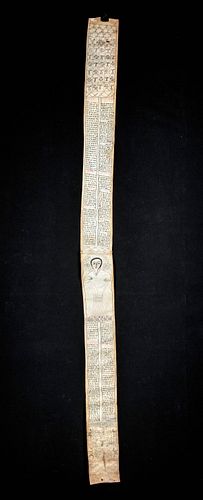18th C. Ethiopian Healing / Prayer Scroll on Vellum
Lot 104
About Seller
Artemis Gallery
686 S Taylor Ave, Ste 106
Louisville, CO 80027
United States
Selling antiquities, ancient and ethnographic art online since 1993, Artemis Gallery specializes in Classical Antiquities (Egyptian, Greek, Roman, Near Eastern), Asian, Pre-Columbian, African / Tribal / Oceanographic art. Our extensive inventory includes pottery, stone, metal, wood, glass and textil...Read more
Categories
Estimate:
$600 - $800
Absentee vs Live bid
Two ways to bid:
- Leave a max absentee bid and the platform will bid on your behalf up to your maximum bid during the live auction.
- Bid live during the auction and your bids will be submitted real-time to the auctioneer.
Bid Increments
| Price | Bid Increment |
|---|---|
| $0 | $25 |
| $300 | $50 |
| $1,000 | $100 |
| $2,000 | $250 |
| $5,000 | $500 |
| $10,000 | $1,000 |
| $20,000 | $2,500 |
| $50,000 | $5,000 |
| $100,000 | $10,000 |
| $200,000 | $20,000 |
About Auction
By Artemis Gallery
Oct 22, 2020
Set Reminder
2020-10-22 10:00:00
2020-10-22 10:00:00
America/New_York
Bidsquare
Bidsquare : Ancient & Ethnographic Art Through The Ages
https://www.bidsquare.com/auctions/artemis-gallery/ancient-ethnographic-art-through-the-ages-5850
Ancient art from Egypt, Greece, Italy and the Near East, as well as Asian, Fossils, Pre-Columbian, Native American, African / Tribal / Oceanic, Fine art, and much more! All categories, all price ranges... all legally acquired and guaranteed to be as described or your money back. Artemis Gallery info@artemisgallery.com
Ancient art from Egypt, Greece, Italy and the Near East, as well as Asian, Fossils, Pre-Columbian, Native American, African / Tribal / Oceanic, Fine art, and much more! All categories, all price ranges... all legally acquired and guaranteed to be as described or your money back. Artemis Gallery info@artemisgallery.com
- Lot Description
Africa, Ethiopia, ca. 18th to 19th century CE. A very long handwritten healing scroll, written in the distinctive Ge'ez (Ethiopic) language, and comprised of two pieces of vellum sewn together at the center with calligraphic prayer passages in black and red ink as well as figural imagery. The names of the people being prayed for, along with the names of saints or other important personages, are highlighted in the text by red writing. Most of the literature of Christian Abyssinia is written in the Ge'ez language and comes from the ancient Aksumitic Empire. Ethiopians come from one of the oldest Christian countries and practice a distinctive form of the religion, embodied in the Ethiopian Orthodox Tewahedo Church, which has a large and diverse Biblical canon, much of which would not be familiar to other Christians. Size: 4" W x 59.5" L (10.2 cm x 151.1 cm); 8" W x 64" L(20.3 cm x 162.6 cm) in plexiglass case
The Metropolitan Museum of Art has several Ethiopian healing scrolls in their collection (accession numbers 2012.5, 2011.377, and 95.66). According to the Metropolitan Museum of Art Heilbrunn Timeline of Art History essay written by Kristen Windmuller-Luna (Department of Art and Archaeology, Princeton University), "Ethiopian healing scrolls eliminate illness by purging evil spirits and demons from a sick person. Part of a larger healing ritual, the scrolls were commissioned by the illiterate to combat grave illnesses. While plant and animal medicines alleviate physical symptoms, the medicinal scrolls alleviate spiritual symptoms. A pan-religious phenomenon practiced among Jews, Christians, and Muslims in the northern regions of Amhara and Tigray, the scrolls restore health by utilizing written words and talismanic images imbued with magical protective powers."
Provenance: private J.H. collection, Beaverton, Oregon, USA, acquired in March 2006; ex-private Chicago, Illinois, USA collection
All items legal to buy/sell under U.S. Statute covering cultural patrimony Code 2600, CHAPTER 14, and are guaranteed to be as described or your money back.
A Certificate of Authenticity will accompany all winning bids.
We ship worldwide and handle all shipping in-house for your convenience.
#151125Has not been examined outside the plexiglass mounting. Vellum shows nice signs of age, darkening, some creasing, losses to peripheries, a few inactive insect losses (upper and lower ends), some handwritten text in pen near the central figure, and a few tears as shown. Inscription and imagery are still vivid.Condition
- Shipping Info
-
All shipping is handled in-house for your convenience. Your invoice from Artemis Gallery will include shipping calculation instructions. If in doubt, please inquire BEFORE bidding for estimated shipping costs for individual items.
-
- Buyer's Premium



 EUR
EUR CAD
CAD AUD
AUD GBP
GBP MXN
MXN HKD
HKD CNY
CNY MYR
MYR SEK
SEK SGD
SGD CHF
CHF THB
THB
















